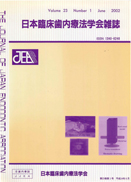Volume 22, Issue 2
Displaying 1-16 of 16 articles from this issue
- |<
- <
- 1
- >
- >|
Review Article
-
2001Volume 22Issue 2 Pages 115-118
Published: 2001
Released on J-STAGE: June 30, 2018
Download PDF (398K) -
2001Volume 22Issue 2 Pages 119-125
Published: 2001
Released on J-STAGE: June 30, 2018
Download PDF (644K) -
2001Volume 22Issue 2 Pages 126-128
Published: 2001
Released on J-STAGE: June 30, 2018
Download PDF (311K) -
2001Volume 22Issue 2 Pages 129-137
Published: 2001
Released on J-STAGE: June 30, 2018
Download PDF (19823K) -
2001Volume 22Issue 2 Pages 138-143
Published: 2001
Released on J-STAGE: June 30, 2018
Download PDF (4150K)
Original Article
-
2001Volume 22Issue 2 Pages 144-153
Published: 2001
Released on J-STAGE: June 30, 2018
Download PDF (70900K) -
2001Volume 22Issue 2 Pages 154-157
Published: 2001
Released on J-STAGE: June 30, 2018
Download PDF (577K) -
2001Volume 22Issue 2 Pages 158-160
Published: 2001
Released on J-STAGE: June 30, 2018
Download PDF (445K) -
2001Volume 22Issue 2 Pages 161-169
Published: 2001
Released on J-STAGE: June 30, 2018
Download PDF (807K) -
2001Volume 22Issue 2 Pages 170-174
Published: 2001
Released on J-STAGE: June 30, 2018
Download PDF (3728K) -
2001Volume 22Issue 2 Pages 175-177
Published: 2001
Released on J-STAGE: June 30, 2018
Download PDF (9375K)
Case Report
-
2001Volume 22Issue 2 Pages 220-222
Published: 2001
Released on J-STAGE: June 30, 2018
Download PDF (8741K) -
2001Volume 22Issue 2 Pages 223-228
Published: 2001
Released on J-STAGE: June 30, 2018
Download PDF (23372K) -
2001Volume 22Issue 2 Pages 229-231
Published: 2001
Released on J-STAGE: June 30, 2018
Download PDF (5949K) -
2001Volume 22Issue 2 Pages 232-237
Published: 2001
Released on J-STAGE: June 30, 2018
Download PDF (21853K)
Medical Essay
-
2001Volume 22Issue 2 Pages 238-241
Published: 2001
Released on J-STAGE: June 30, 2018
Download PDF (330K)
- |<
- <
- 1
- >
- >|
